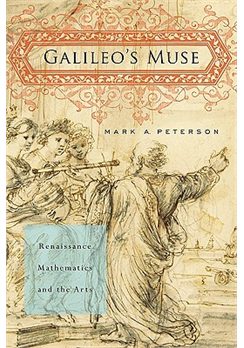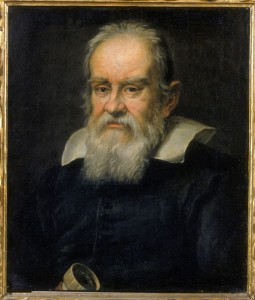Book Review: A Brave New Perspective on the Arts and Sciences — “Galileo’s Muse”
“Galileo’s Muse” is a gem of a book: shedding new light on a figure as well-examined as Galileo is no simple task. Peterson does so with aplomb, while also telling a fascinating story of the evolution of mathematics and the arts.
Galileo’s Muse: Renaissance Mathematics and the Arts by Mark A. Peterson. Harvard University Press, 352 pages, $28.95.
By Justin Grosslight
Arts Fuse Interview with Mark Peterson about Galileo’s Muse
Nearly everyone familiar with Galileo knows something of his scientific exploits. Less known, however, is the relationship between Galileo’s mathematics and his humanities background. Academic Mark A. Peterson has been investigating historical connections between Renaissance mathematics and the humanities for over a decade, and Galileo’s Muse tantalizingly asserts his discoveries. Trained as a physicist and mathematician, the author urges us not to expect a linear narrative. Instead, he divides his book into sections on poetry, painting, music, and architecture: the approach encourages readers to follow “one stream after another.” Only at the end of the book, when the sections fall into an illuminating pattern, does the richness and complexity of the connections between mathematics and the arts emerge.
Galileo’s Muse can be read as two parallel stories. The first emphasizes the changing nature of mathematics during the Renaissance. Originally part of the scholastic quadrivium, math during the period paired geometric pursuits with astronomy and arithmetic inquiries with music. But in time these pairings became creatively scrambled. Peterson argues that by the end of the Renaissance, arithmetic was applied to geometry problems and geometric thought was brought to music. Furthermore, the author suggests that as mathematicians began to operate outside the university system, they developed their own set of interests. No longer fettered by scholastic tradition, many mathematicians neglected astronomical work to solve applied problems—often tying quantitative work to experiments. They drew their inspiration for practical mathematics from authors of Hellenistic Greece, Galileo representing the culmination of this metamorphosis.
Peterson provides engaging vignettes to tell his story of mathematical evolution, viewing seemingly disparate actors as part of a tantalizingly unified whole. Galileo’s Muse dramatizes the competitive natures of Tartaglia, Ferrari, and Cardano as they take on solving polynomial equations. The musical knowledge of Galileo’s father, Vincenzo Galilei, and the astronomer Johannes Kepler are acknowledged, as well as the intellectual feats of Piero della Francesca and Luca Pacioli. The culmination of these developments arrives in the 1627 Oration in Praise of Mathematics, a work lauding the application of quantitative methods in mathematical physics. Though ostensibly authored by Galileo’s student, Niccolò Aggiunti, Peterson contends that Galileo himself composed this work. His evidence to support this claim could be stronger, but the hypothesis is credible enough, particularly given Galileo’s close relationship with Aggiunti. The connection is crucial, because the Oration connects a tale of mathematical ferment to a brilliant reconsideration of the origins of Galileo’s thought.
In the second of the book’s narratives, Peterson argues that, though Galileo deployed arithmetic and geometry in experimental science, the inspiration for his work was not the mathematical milieu in which he lived. Rather, Peterson posits that “Galileo’s background in the humanities and the arts was formative for his approaches in mathematics and the emerging sciences.” He elegantly talks about how Galileo read Dante’s Divine Comedy for its mathematical argument about the physical dimensions of hell, not for its poetic content. He also notes how developments in artistic perspective may have influenced Galileo’s notion of relativity and movement.
Most importantly, Galileo’s interest in experimental science and the necessity for making approximations stems from musical tests performed with his father, Vincenzo. While some of Peterson’s examples are stronger than others, all are presented with a cogency that provokes fresh thinking. After all, Galileo’s mathematical heroes—Pythagoras, Euclid, Apollonius—were active in Hellenistic Greece during an era when applied mathematics flourished. Thus the notion of unifying theory and practice in the Renaissance was not a new idea. It had been abandoned during the Roman Empire, when intellectuals preferred the broad, philosophical speculations of Aristotle and purely theoretical claims of Euclid to the world of applied math. Galileo, therefore, can be seen as a catalyst who revived a tradition that lay dormant for nearly 2,000 years.
What’s valuable about this view of Galileo is not just its historical revisionism but its relevance to cultural argument today. Since novelist C. P. Snow lamented the chasm dividing the “Two Cultures” of scientists and literary intellectuals 50 years ago, the growing gap between scientists and their humanist counterparts has become a self-defeating bromide. Galileo’s Muse helps to bridge this divide. Using the strength of the humanities to build upon his mathematics, Galileo serves as an iconic ambassador between both worlds—admittedly as the representative of a time when the the arts and sciences were more intertwined.
Still, Peterson’s book presents a lucid attempt to foster a dialogue between the sides today. For historians of science, Galileo’s Muse represents a healthy shift away from a generation of Galileo scholarship that mainly focused on his ideas about physics, his Church confrontations, and his patronage tactics. For scientists, the volume serves as a poignant reminder that quantitative ideas cannot exist apart from a rich world of books, art, and music. Boasting a clear writing style that will appeal to a broad and curious readership, Galileo’s Muse represents an excellent departure point for future scholarly research, especially the growing opportunities for interdisciplinary endeavors.
Galileo’s Muse most glaring weakness comes with its epilogue. After 13 captivating chapters, each on the changing nature of Renaissance mathematics, Peterson sells himself short in his conclusion. Rather than building on the innovative claims he makes about mathematical development and its relationship to the humanities, Peterson looks backwards, focusing on previous Galileo studies. He concludes that scholars have unfairly underestimated Galileo’s engagement with Copernicanism, thereby overlooking his scientific contributions to problems in mechanics and geometry. Many historians of science, no doubt, would agree with Peterson’s claim. In fact, it already has been discussed in Peter Dear’s Discipline and Experience: The Mathematical Way in the Scientific Revolution and Domenico Bertolini Meli’s Thinking With Objects: The Transformation of Mechanics in the Seventeenth Century. Both of these well known books are conspicuously absent from Peterson’s notes, which could cause concern for specialists about the parameters of his research. Nevertheless, Galileo’s Muse is a gem of a book: shedding new light on a figure as well-examined as Galileo is no simple task, and Peterson does so with aplomb.
Harvard University Press’s podcast with Mark A. Peterson on Galileo’s Muse
Tagged: Galileo's Muse, Mark Peterson, arts, history of science, humanities, mathematics



